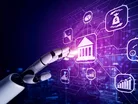AI and the future of global trade

Artificial intelligence (AI) is becoming entrenched in our daily lives, but the technology is still surrounded by misconceptions and skepticism. Ask the public and they may jump to dystopian scenarios where robots have taken over the world.
While this makes for a good sci-fi blockbuster plot, the reality is different and more benign. Those products that Amazon suggested you buy? AI. That TV series you were recommended to watch on Netflix? AI. That self-driving Tesla car you crave to take for a spin? You guessed it: AI.
There is no single industry that is not being re-shaped by technology. Until recently, however, there was one noteworthy exception: global trade. Fortunately, that is slowly changing.
The mechanism that underpins global trade – trade finance – is an industry that remains largely paper-based and reliant on manual processes. This US$18tn a year industry is now being influenced by a new wave of technological innovation, including AI.
Exploring the potential of AI in Trade Finance
AI refers to the use of computer-aided systems to help people make decisions or make decisions for them. It relies on large volumes of data and models to make sense of information and draw intelligence.
In trade finance, AI is helpful in analysing quantitative data, and the repetitive nature of trade finance means that there is a lot of non-traditional data at our disposal.
This means that when trade finance providers need to assess the risks of funding a transaction, AI models can be a very efficient tool for data analysis and reveal intelligence and risks relating to small companies.
AI helps the industry move beyond traditional credit scoring processes, which are often outdated and remain reliant on historical accounting entries – a barrier that prevents small companies from accessing trade finance and has resulted in a $1.5tn global shortfall.
Overcoming the barriers
AI can tackle this shortfall by creating accurate credit scoring models. This can include a company’s payment history, measure the risks of funding a transaction, identify supply chain risks, and benchmark them against their peer group.
Trade finance providers can use this information to communicate effectively with their SME clients, ultimately helping establish better business relationships.
Towards a technological utopia?
The adoption of AI has the potential to do a lot of good in the industry, and the industry is in the early stages of radical transformation.
Advances are driven by fintechs as well as a willingness to change. The industry is working together to create new infrastructure for distributing trade finance assets to other investors in a transparent, standardised format.
The creation of infrastructure is possible due to improvements in technology and integrated across the trade ecosystem in cooperation with banks, insurers, and other industry participants.
It’s collaboration at its best: together, the industry is using technology to re-shape global trade as we know it.
This article was contributed by Michael Boguslavsky, Head of AI at Tradeteq

